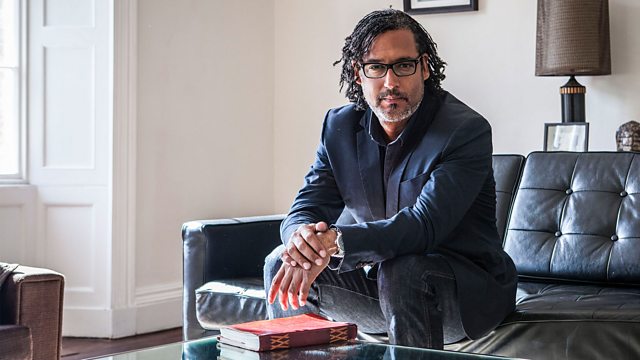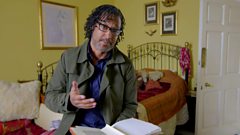
Episode 2
Tracing the residents from the 1880s to 1900s, David discovers a family torn apart by catastrophe. The house becomes a refuge for destitute street girls, and hosts a seance.
In episode two, David Olusoga tracks the lives of the residents of Ravensworth Terrace through the turbulent decades from the 1860s to the 1900s.
In 1861 the house is occupied by elderly widow Mary Colbeck, living here with her 13-year-old grandson James Todd. David is curious about this setup – why is James living with his grandmother? Where are his parents? Peeling back ten years to the 1851 census, David discovers that Mary Colbeck is a well-to-do landowner. She lives on a large estate and owns three other farms. Her grandson James is one of eight children, the son of Mary’s daughter Margaret, who has married local industrialist Frederick Todd. Frederick’s family own a large glass-making factory on the banks of the Tyne.
But David discovers that this apparently respectable and well-matched couple have fallen into financial difficulty. As historian Cathy Ross explains, Newcastle’s glass-making industry is changing rapidly, and the Todds’ business fails to keep pace with the times. David then discovers a series of extraordinary newspaper articles that describe what happened next. Threatened by the forced sale of his factory, Frederick Todd attacks one of his creditors with a knife before trying to take his own life. He is thrown into gaol.
The scandal not only damages the family’s reputation, but forces Mary to sell her estate in the country and downsize to Ravensworth Terrace, in order to free up money to support her family.
David then discovers a death certificate for Frederick Todd, who dies in 1864, aged just 46. Three years later, his wife Margaret also dies in extraordinary circumstances. Reports describe her as an alcoholic who set herself on fire while drunk. This appalling incident is witnessed by her six-year-old daughter Mary Victoria. The death and scandal have devastating effects on all Margaret’s children, now orphaned and dependent on their grandmother Mary. She does her best to support them, but sadly there is no happy ending for her grandson James, who dies of consumption aged 22, nor for little Mary Victoria, who dies in a convalescent home in Torquay, aged just ten. In 1878, Mary Colbeck dies at Ravensworth Terrace.
By now the neighbourhood is moving down the social scale. After a brief spell as lodgings, the house at Ravensworth Terrace is taken over by an organisation called the ‘Diocesan Home for Friendless Girls’. As David discovers from historian Fern Riddell, the role of this organisation is to rescue girls from the street who are at risk of falling into prostitution and trains them up for domestic service. Tracing the young women trainees, most of them orphaned, abandoned or penniless, is a difficult task. But David discovers that one young girl, Alice Coulson, who comes to live at the Home at the age of 15, has a happy ending to her story. Alice finished her training in Ravensworth Terrace, and goes to work for a wealthy family in the seaside town of Filey, where she meets her future husband.
The next resident of Ravensworth Terrace is draper Bevan Harris. David discovers that he is not just a businessman, but an enthusiastic follower of Spiritualism, the belief that the dead can communicate with the living. He even hosts seances at the house in Ravensworth Terrace, as David discovers from experts Roger Luckhurst and Pat Beesley. The reason for his unwavering belief soon becomes clear. David discovers numerous deaths in Bevan’s family, and with infant mortality accounting for around a quarter of all deaths in the 1890s and life expectancy around 46, it is little surprise that people like Bevan Harris sought out the solace of Spiritualism. Harris himself writes ‘oh what a blessing is Spiritualism in these trying circumstances’ after the premature death of his wife from cancer.
In 1894, Bevan Harris moves to Nottingham to continue his Spiritualist mission, and the house sees the arrival of new tenants. Mary Ellen Oram is a draper and her husband William a captain in the merchant navy. To find out more about them David arranges to meet their descendant, Tony Holmes. To his surprise, Tony reveals that in 1900, Mary Ellen is committed to the local lunatic asylum, suffering from ‘melancholia’, what would today be termed depression. Money worries are behind Mary Ellen’s mental health problems. By 1898 her business had failed and her husband loses his job after being found guilty of overloading his ship with coal.
And as Deborah Sugg Ryan explains, Mary Ellen opened her business at exactly the wrong time, when high street drapers were facing stiff competition from new department stores. Mary Ellen is institutionalised for two years, and, David discovers, that she is not the only family member to spend time there. Her husband William was sent to the asylum after suffering from a stroke. Unlike his wife, who was released after two years, the unfortunate William Oram died just eight months after his admission.
Last on
More episodes
Previous
Next
Clip
-
![]()
Tragedy strikes the Todds
Duration: 01:13
Credits
| Role | Contributor |
|---|---|
| Presenter | David Olusoga |
| Editor | Stuart Davidson |
| Producer | Jonathan Rowlands |
| Executive Producer | Maxine Watson |
| Series Producer | Mary Crisp |
| Producer | Hugo Macgregor |
| Director | Hugo Macgregor |
| Writer | David Olusoga |
| Composer | Paul Honey |
| Production Manager | Zarina Dick |
Broadcasts
- Mon 15 Apr 2019 21:00
- Tue 16 Apr 2019 23:15�鶹������ҳ��� Two except Northern Ireland & Northern Ireland HD
- Fri 3 May 2019 02:55
- Thu 14 Oct 2021 20:00
- Fri 15 Oct 2021 02:20

